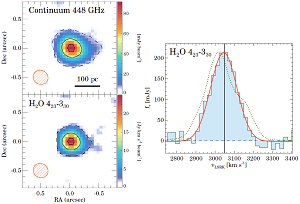- Details
- Published on 03 May 2017
Vol. 601
In section 1. Letters to the Editor
First detection of the 448 GHz H2O transition in space

Water is a key molecule to probe dense and warm regions in the interstellar medium, because of its chemistry as well as its coupling to the far-infrared. This work presents the first detection of the ortho-H2O 4_23 - 3_30 transition at 448 GHz in space. Due to a strong opacity in the terrestrial atmosphere, this line had not till now been observed in nearby molecular clouds. The line is found in emission with ALMA in a redshifted luminous infrared (IR) galaxy ESO 320-G030. Water excitation models have long predicted the maser nature of this transition, pumped by collisions when the kinetic temperature is around 1000K and the hydrogen density 10^5 cm3. On the contrary, and surprisingly, the line is primarily excited by the intense far-IR radiation field that is present in the nucleus of this galaxy. This field extends over a region of 65 pc in diameter and shows a regular rotation pattern compatible with the global molecular and ionized gas kinematics. This H2O transition is therefore a probe of deeply buried galactic nuclei thanks to the high dust optical depths (NH > 4 10^24 cm2) required to efficiently excite it.


